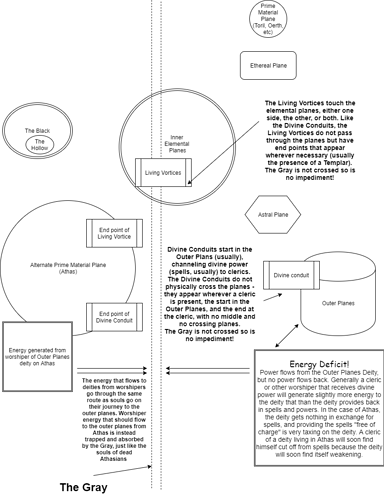A fun vignette, indeed.
It is interesting to imagine the meetings of beings such as these. Whatever would such souls say to one another?
Given that a strong tradition is in place that they are all Lawful Evil, I do imagine there is some order to their meetings, though I imagine they are very rare, at least to mortal thinking. I speculate that they all very much despise and mistrust one another. But they are locked together in hatred due to a very great fear (a fear which likely gives much meaning to their existence), and are in any case forced to cooperate by the absolute tyranny of the Dragon, who exercises their collective will.
It is interesting, by the way, that in the epilogue of the Amber Enchantress, it seems that Borys does not immediately object to the notion that Kalak intended to become a full-fledged dragon. See this exchange:
Tithian shook his head defiantly. “No, we did you a favor. Kalak was trying to become a dragon so he could take your place.”
“I’ll be the judge of what favors me and what does not,” the great beast snarled. “All sorcerer-kings are dragons of one kind or another, though they assume different shapes to suit their tastes. If Kalak wished to fashion himself after my form, that was his business — but he would not have dreamed of taking my place. Saying such things only shows how little you know about what you’ve taken upon yourself.”
Though I imagine Borys would have chafed at a 30th level peer, by this statement it seems he was comfortable in his position as “Leader of the Revolt” as Rajaat put it. Borys’ authority as Master of the Black Sphere seems to have been secure.
It wonder what the dynamics between the Champions would have been had Kalak become 30th level. Would Borys and the others really have accepted it? Nok calculated with certainty that should Kalak transform into a fully metamorphosed dragon that he would be pushed outside of the Tablelands and to the Forest Ridge. I think that may have been true. Kalak seemed driven to finish the metamorphosis, and was utterly heedless of the consequences, even when it came to the maintenance of the Prison and his standing with the other Champions. Perhaps he thought that as a 30th level dragon he would at last be able to transcend the concerns of a sorcerer-king, and aloof to all things do as he would upon the world with no remaining concerns. The old Champions would see to the Prison. With Tyr gone, what would Kalak have to offer in terms of a levy? And what were they going to do, kill him? He may have thought that would no longer be a manageable assassination at 30th level, and if he planned to ravage whatever was left of the outer world after his metamorphosis, what would be the driving factor for them to kill him anyway? Beyond the Ringing Mountains, he would no longer be much of their concern.
Anyhow, it is interesting to imagine their internal dynamics. It seems that Dregoth was assassinated during the era of Borys’ bestial phase (which shows how early and how far advanced Dregoth was when compared with his peers), so I suppose Abalach-Re and the others needed no approval from the Dragon yet for an assassination of one of their own. But once he regained his reason, did such matters need to go before the Dragon for his approval, or at least his tacit consent? How were such appeals handled? How often did they meet? Where did they meet? Did the Dragon allow them to meet without him? How much did they cooperate, or how much did they act independently, fearful of their peers and even more fearful of the Dragon? All interesting questions your vignette brings up redking.
